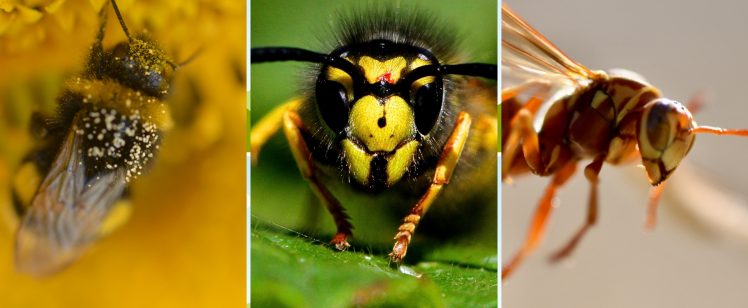-
- Jun 04
-
pestcontrol

- 0
Bees, Wasps, and Hornets, Oh My – Know the Differences and When to Act
A Bee? A Wasp? or a Hornet?
While nearly everyone can identify the honey bee, because the species is so frequently in the news, most people don’t know the difference between stinging insects – bees, wasps, hornets, and other stinging insects. Since spring is here and summer is fast approaching, the stinging insects of Southern California will be out in force invading picnics, barbecues, sporting events, and the fun outdoor activities that come with the season.
With that in mind, the Preferred Pest Control team has created this guide to help you identify stinging insects in and around your lawn and help you know when and how to act should the bees, wasps, hornets, and others cause a problem.
Honeybees
Ever popular with the need for protection, are small (about a half inch in length), oval in shape with yellow and brown banding. They are crucial to the earth’s ecosystem because they are the pollinators for more than 100 species of plants. Generally, they are docile, but when their hives are under attack, they will defend it with a full scale defense. After a single sting, the honey bee dies, so hive invaders will be aggressively attacked by a large army of bees.
Bumblebees
Another species of pollinators crucial to the earth’s ecosystem. Bumbles bees are soft and fuzzy, with black and yellow coloring, and are plumper and stouter than honey bees. They don’t often cause problems in your garden, but spend their time happily pollinating. Bumble bees are not aggressive, and only the females can sting, doing so when they feel threatened. Generally they will only become a problem in your yard, if the area becomes overpopulated.
Carpenter Bees
They resemble as Bumble bees, though they are not nearly as soft and fuzzy in appearance. Most are black with only yellow markings on their heads. Carpenter bees, though they appearance suggest otherwise, are not aggressive and will not defend their nests. They are destructive because they bore holes in wooden posts (decks and porches), rafters, siding, and more.
Paper Wasps
Known as common wasps. They can be nearly an inch in length, and feature yellow and brown striping. They like to nests in door frames, and under eaves and rafters. Paper wasps only become aggressive when their nests are disturbed.
Yellow Jackets
They look similar with wasps, but have black and yellow heads with a stiped body. They nest in eaves or attics as well as in the ground. They are very aggressive, sting repeatedly, and are therefore dangerous to humans.
Hornets
They have a similar appearance to paper wasps, but are larger. Their nests are ball shaped and often found in trees or attic spaces or against the walls of your home. Like yellow jackets, they are extremely aggressive in defending their nests, making them dangerous to remove.
Preferred Pest Control is ready to help when bees, yellow jackets, hornets, and other stinging insects pose a threat to your family, your home, and your yard.
We offer our Pest Control Services throughout many Southern California Counties and Cities:
- Orange County Pest Control Services
- Anaheim Pest Control Services
- Westminster Pest Control Services
- Fountain Valley Pest Control Services
- Irvine Pest Control Services
- Cypress Pest Control Services
- Garden Grove Pest Control Services
- Fullerton Pest Control Services
- Huntington Beach Pest Control Services
- Newport Beach Pest Control Services
- Costa Mesa Pest Control Services
- Seal Beach Pest Control Services
Our Contact Information:
Address: 17150 Newhope #904 Fountain Valley, CA 92708
Phone: (714) 486-2637
Fax: (714) 274-9867
Email: info@preferredpestcontroloc.com
Website:https://www.preferredpestcontroloc.com/Preferred Pest Control is proud to serve Fountain Valley, Huntington Beach, Costa Mesa, and other surrounding Orange County communities with world-class pest control services. Let us know how we can help, and we’ll be in touch shortly with your free quote.
We accept all major credit cards!

